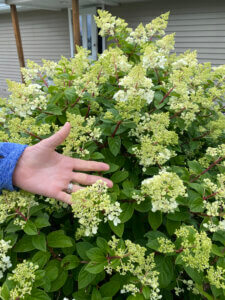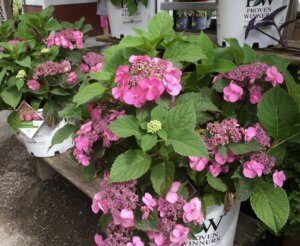
Hydrangeas are a genus of woody perennial shrubs. The majority are small to medium-sized shrubs, and four species and their varieties have found their way into American gardens. Flower forms are variable: lacecap flowers are more or less flattened with small flowers in the center and larger flowers around the edge; mophead flowers are arranged in a dome shape; ball hydrangea flowers are arranges in large, showy balls, and panicle hydrangea flowers are arranged in closely packed pyramidal clusters. Hydrangeas are native to western Asia, South America and eastern and southeastern North America. Hydrangeas can tolerate all sorts of shade or sun conditions, but cannot withstand dry soil conditions.
Hydrangea paniculata (Panicle Hydrangea)
Panicle hydrangeas are virtually indestructible, always a plus in a family with small children or pets. They are native to southern and eastern Asia. They can grow up to 8 feet, but are usually shorter. Paniculata does well in full sun to partial shade and is hardy in zones 3-8. The flowers are on cone-shaped panicles, up to 16 inches long, and they attract pollinators. Prune the stems back to 6 inches tall in late winter or early spring. Here are some excellent varieties:
‘Moonrock®’ This gorgeous 5-6 foot tall shrub features creamy white flowers with lime green centers. Flowers in late summer but lasts through fall.
‘Firelight®’ This new, cold-hardy 6-foot hydrangea sports creamy white flowers on large panicles that bloom in summer then gradually turn pink in fall.

Hydrangea quercifolia (Oakleaf Hydrangea)
Oakleaf hydrangeas are hardy in Zone 5-8. They are an easy to grow shrub and are native to the southeastern United States. Their leaves resemble large oak leaves 4-12 inches long, hence the name. Height varies from 3 feet to 8 feet. They don’t need pruning other than removal of dead branches and blooms. The large panicle flowers appear in May to July and stay on the plant until frost. They grow in full sun to part shade, tolerate heat and like moist, well drained soils. They attract pollinators, but are not deer resistant. Some of the best varieties are:
‘Gatsby Pink’ has large pink blooms. It is 6 feet to 8 feet tall and wide, so give it some room.
‘Ruby Slippers’ is a dwarf variety only 3 feet tall and 3 to 4 feet wide ‘Ruby Slippers’ made itself into our garden a few years ago. It has 9 inch flowers that turn deep red, and is a fast growing quick blooming shrub.
Hydrangea arborescens (Smooth Hydrangea)
Smooth hydrangeas are native to the eastern United States. They will grow in all soils including clay. Smooth hydrangeas like sun to part shade, have few pests and are hardy in zones 3-9. They have a ball type flower form. Prune to the ground in late winter. Here are a couple of outstanding varieties:
‘Incrediball’ has white balls up to 12 inches in diameter. They are 5 feet tall and wide, are long bloomers and will grow rapidly, blooming the first year.
‘Invincibelle’ is a Proven Winner. it has hot pink flowers that fade to soft pink and is a rebloomer from early to late summer. It is only 3 to 4 feet tall and wide.

Hydrangea macropylla (Bigleaf Hydrangea)
This is a native of Japan. Flowers are either mopheads or lacecaps (not both). Mopheads will remain attractive longer. Other than that, they have the same growth and care characteristics. Flower colors depend on soil pH. Soil pH below 6.0 yields bluish blooms; soil pH above 7.0 yields reds; soil pH between 6 and 7 yields blooms of bluish-pink. Hardy in Zones 6-9 and may grow up to 7 feet tall. Prune late fall to early spring by cutting branches back to the first large new bud. They do best in full sun to partial shade and need moist but well drained soil. They do not attract pollinators, but most information sources consider them to be deer resistant. Here are some excellent varieties:
‘Big Daddy’ prefers full to partial shade. Enormous ball-shaped flowers up to 14 inches in diameter. Shrubs have a rounded appearance and grow 5-6 feet tall.
‘Masja” is a dwarf mophead hydrangea with flowers up to 6 inches in diameter. It blooms in mid to late summer. The flowers maintain their color for a long time, then turn a metallic hue. Leaves may turn reddish in fall. Perfect in containers too.
About Teri Keith

